ATI's X8xx CrossFire Graphics Arrive
by Derek Wilson on September 26, 2005 1:00 PM EST- Posted in
- GPUs
Gaming Performance
We have already taken a look into gaming performance under CrossFire when Gigabyte sent us some preproduction samples. We reran the numbers on ATI's final boards and drivers and here is what we ended up with.The numbers with no AA show CrossFire doing very well; even beating the 7800 GTX SLI in the very CPU limited Halflife 2. A bigger deal is that the X850 CrossFire actually outperformed the single 7800 GTX in Splinter Cell: Chaos Theory. Doom 3 generally favors NVIDIA hardware, and while the CrossFire setup can't match the 6800 Ultra SLI, it performs on par with the 7800 GTX. Battlefield 2 is a close race between the 6800 Ultra SLI and the X850 CrossFire setups.
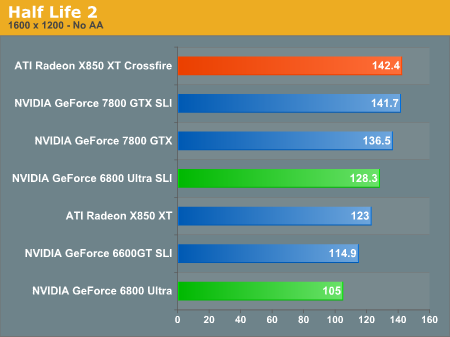
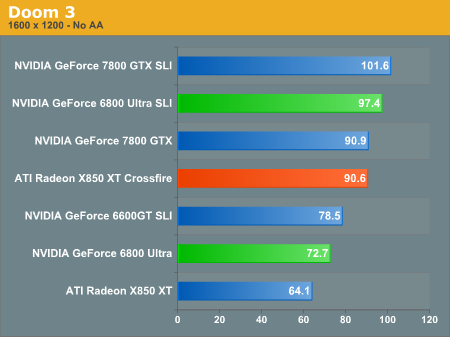
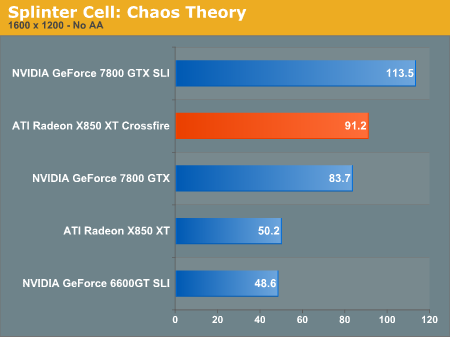

With AA enabled, CrossFire performs similarly well. The 7800 GTX SLI beats it in Halflife 2 this time around (even though both parts are still essentially CPU limited), and CrossFire gains ground on the NVIDIA parts. The performance impact of AA on NVIDIA hardware is slightly greater than on ATI hardware. The AA quality of ATI hardware is also better. Again Battlefield 2 is a close race, with a leadership changes favoring CrossFire.


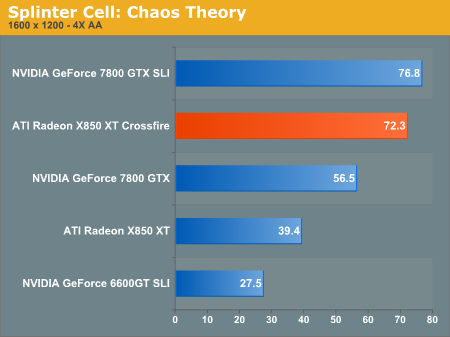
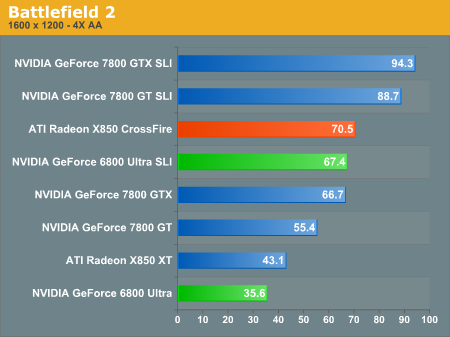
For those who wish to look back at our previous CrossFire article, you will quickly see that the CrossFire results have not changed much at all. The biggest difference here is Halflife 2 where CrossFire was already a stellar performer.
We didn't publish the results in the last article, but Battlefield 2 is now performing better having moved away from SuperTiling. The results before were not that bad, but we definitely see better numbers this time around.










76 Comments
View All Comments
DerekWilson - Tuesday, September 27, 2005 - link
Actually, we took our time. Copied a few numbers down incorrectly. Sorry about that.Googer - Monday, September 26, 2005 - link
Why hasn't anyone tested these on an nForec 4 motherboard yet? ATL Crossfire on a DFI SLI motherboard, will it work?OvErHeAtInG - Monday, September 26, 2005 - link
Um, no. In the future, with different drivers? Who knows. But nvidia is unlikely to provide good nF4 drivers for people who are buying ATI cards?Live - Monday, September 26, 2005 - link
How is the total power draw calculated, before or after the PSU?DerekWilson - Monday, September 26, 2005 - link
Sorry I didn't explain -- I'll add the infopower draw is measured before the PSU -- so yes, the dissipated power of the supply itself is included. And I do know that power draw at the wall is not exactly linear with respect to power supplied to the computer. At the same time, watts pulled from the wall are what we pay for right? :-)
Dangher - Monday, September 26, 2005 - link
You do realise that without proper homework you are just perpetuating sensationalism, right? The TMDS receiver has nothing to do with actual framerate or screen refresh, you do know that, right? You are aware that 1600x1200@60Hz in the TMDS translates into about 2500x1500@100Hz when doing SLI (or Crossfire, as is the case), right? Now go do your homework and correct the article (you're liable to be sued for libel by ATI btw).overclockingoodness - Monday, September 26, 2005 - link
LOL, you are such an idiot. AnandTech can't be sued for libel; did you ever take business 101? Apparently not. Please keep your mouth shut on the things you have no clue about.DerekWilson - Monday, September 26, 2005 - link
sorry m8, don't know where you got your info, but regaurdless of the fact that it is possible for the output to be run at a higher resolution than the TMDS receiver doesn't matter when the product manager of CrossFire at ATI states that the output of CrossFire will be locked to 1600x1200@60Hz *because* of the single link TMDS receiver.I'm sorry if I didn't make it completely clear that ATI could decouple their output from the reciever but they have chosen not to.
Pete - Monday, September 26, 2005 - link
The TDMS receiver is specced to the TDMS transmitter on the slave card, so it is indirectly tied to the screen refresh. I don't recall Derek saying it limits the frame rate, but obviously you can't see more frames than screen updates, so it can potentially limit the visible framerate, too. Yes, that applies to anything with a different frame than refresh rate, but XFire is fairly limited at 16x12@60Hz.And, no, you don't double up TDMS rates with XF, as the CE (Compositing Engine) doesn't have a buffer to accomodate a refresh rate independent of TDMS rate (which is, again, limited to 16x12@60Hz).
Dangher - Monday, September 26, 2005 - link
It is late and I can't be bothered to look for the techie article on this particular problem and why it's been blown out of proportion, but I will do it tomorrow and post a link here. My apologies to Derek if I offended him, it really is late. Link upcoming.